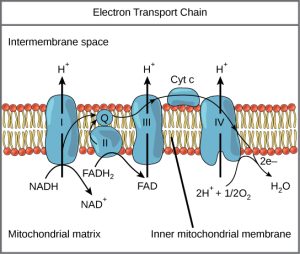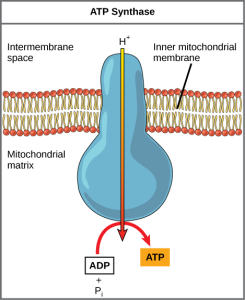10.4 Oxidative Phosphorylation
Learning Objectives
By the end of this section, you will be able to do the following:
- Describe how electrons move through the electron transport chain and explain what happens to their energy levels during this process.
- Explain how a proton (H+) gradient is established and maintained by the electron transport chain.
You have just read about two pathways in glucose catabolism—glycolysis and the citric acid cycle—that generate ATP. Most of the ATP generated during the aerobic catabolism of glucose, however, is not generated directly from these pathways. Instead, it is derived from a process that begins by moving electrons through a series of electron carriers that undergo redox reactions. This process causes hydrogen ions to accumulate within the intermembrane space between the inner and outer mitochondrial membranes. Therefore, a concentration gradient forms in which hydrogen ions diffuse out of the intermembrane space into the mitochondrial matrix by passing through ATP synthase. The current of hydrogen ions powers the catalytic action of ATP synthase, which phosphorylates ADP, producing ATP.
Electron Transport Chain
The electron transport chain (Figure 10.4.1) is the last component of aerobic respiration and is the only part of glucose metabolism that uses atmospheric oxygen. Oxygen continuously diffuses into plant tissues (typically through stomata), as well as into fungi and bacteria; however, in animals, oxygen enters the body through a variety of respiratory systems. Electron transport is a series of redox reactions that resembles a relay race or bucket brigade in that electrons are passed rapidly from one component to the next, to the endpoint of the chain where the electrons reduce molecular oxygen and, along with associated protons, produces water. There are four complexes composed of proteins, labeled I through IV in Figure 10.4.1, and the aggregation of these four complexes, together with associated mobile, accessory electron carriers, is called the electron transport chain. The electron transport chain is present with multiple copies in the inner mitochondrial membrane of eukaryotes and within the plasma membrane of prokaryotes.

Complex I
First, two electrons are carried to the first complex via NADH. This complex, labeled I, is composed of flavin mononucleotide (FMN) and an iron-sulfur (Fe-S)-containing protein. FMN, which is derived from vitamin B2 (also called riboflavin), is one of several nonprotein molecular groups or cofactors in the electron transport chain. Complex I has two major functions, its enzymatic activity (NADH dehydrogenase) and it’s ability to pump four hydrogen ions across the membrane from the matrix into the intermembrane space. This function of Complex I is how a hydrogen ion gradient is established and maintained between the two compartments separated by the inner mitochondrial membrane.
Q and Complex II
Complex II directly receives electrons from FADH2—which does not donate its electrons to complex I. Both Complex I and II, pass the electrons on to ubiquinone B. The Q molecule is lipid soluble and freely moves through the hydrophobic core of the membrane. Once it is reduced (QH2), ubiquinone delivers its electrons to the next complex in the electron transport chain, Complex III. Since the electrons carried by FADH2 bypass Complex I and thus do not energize the proton pump in the first complex, fewer ATP molecules are made from the FADH2 electrons. The number of ATP molecules ultimately obtained is directly proportional to the number of protons pumped across the inner mitochondrial membrane.
Complex III
The third complex is composed of cytochrome b—another Fe-S protein, a Rieske center (2Fe-2S center), and cytochrome c proteins. This complex is also called cytochrome oxidoreductase. Cytochrome proteins have a prosthetic group of heme. The heme molecule is similar to the heme in hemoglobin, but it carries electrons, not oxygen. As a result, the iron ion at its core is reduced and oxidized as it passes the electrons, fluctuating between different oxidation states: Fe++ (reduced) and Fe+++ (oxidized). The heme molecules in the cytochromes have slightly different characteristics due to the effects of the different proteins binding to them, giving slightly different characteristics to each complex. Complex III pumps protons through the membrane and passes its electrons to cytochrome c for transport to the fourth complex of proteins and enzymes.
Complex IV
The fourth complex is composed of cytochrome proteins c, a, and a3. This complex contains two heme groups (one in each of the two cytochromes, a, and a3) and three copper ions (a pair of CuA and one CuB in cytochrome a3). The cytochromes hold an oxygen molecule very tightly between the iron and copper ions until the oxygen is completely reduced by the gain of two electrons. The reduced oxygen then picks up two hydrogen ions from the surrounding medium to make water (H2O). The removal of the hydrogen ions from the system contributes to the ion gradient that forms the foundation for the process that drives the ATP synthase.
Video 10.41. Electron Transport Chain | HHMI BioInteractive Video by biointeractive
ATP Synthase
The free energy from the series of redox reactions just described is used to pump hydrogen ions (protons) across the mitochondrial membrane. The uneven distribution of H+ ions across the membrane establishes both concentration and electrical gradients (thus, an electrochemical gradient), owing to the hydrogen ions’ positive charge and their aggregation on one side of the membrane.
If the membrane were continuously open to simple diffusion by the hydrogen ions, the ions would tend to diffuse back across into the matrix, driven by the concentrations producing their electrochemical gradient. Recall that many ions cannot diffuse through the nonpolar regions of phospholipid membranes without the aid of ion channels. Similarly, hydrogen ions in the matrix space can only pass through the inner mitochondrial membrane by an integral membrane protein called ATP synthase (Figure 10.4.2). This complex protein acts as a tiny generator, turned by the force of the hydrogen ions diffusing through it, down their electrochemical gradient. The turning of parts of this molecular machine facilitates the addition of a phosphate to ADP, forming ATP, using the potential energy of the hydrogen ion gradient.

Dinitrophenol (DNP) is an “uncoupler” that makes the inner mitochondrial membrane “leaky” to protons. It was used until 1938 as a weight-loss drug. What effect would you expect DNP to have on the change in pH across the inner mitochondrial membrane? Why do you think this might be an effective weight-loss drug?
ATP synthase (Figure 10.4.2) is used to generate 90% of the ATP made during aerobic glucose catabolism; it is also the method used in the light reactions of photosynthesis to harness the energy of sunlight. The production of ATP by harnessing the potential energy in the H+ gradient across the inner mitochondrial membrane is also called oxidative phosphorylation. The overall result of these reactions is the production of ATP from the energy of the electrons removed from hydrogen atoms. These atoms were originally part of a glucose molecule. At the end of the pathway, the electrons are used to reduce an oxygen molecule to oxygen ions. The extra electrons on the oxygen attract hydrogen ions (protons) from the surrounding medium, and water is formed. Thus, oxygen is the final electron acceptor in the electron transport chain.

ATP Yield
The number of ATP molecules generated from the catabolism of glucose varies. For example, the number of hydrogen ions that the electron transport chain complexes can pump through the membrane varies between species. Another factor that affects the yield of ATP molecules generated from glucose is the fact that intermediate compounds in these pathways are also used for other purposes. Glucose catabolism connects with the pathways that build or break down all other biochemical compounds in cells, and the result is somewhat messier than the ideal situations described thus far. For example, sugars other than glucose are fed into the glycolytic pathway for energy extraction. In addition, the five-carbon sugars that form nucleic acids are made from intermediates in glycolysis. Certain nonessential amino acids can be made from intermediates of both glycolysis and the citric acid cycle. Lipids, such as cholesterol and triglycerides, are also made from intermediates in these pathways, and both amino acids and triglycerides are broken down for energy through these pathways. Overall, in living systems, these pathways of glucose catabolism extract about 34% of the energy contained in glucose, with the remainder being released as heat.
Video 10.4.2. ATP Synthesis | HHMI BioInteractive Video by biointeractive
Practice Questions
Cyanide inhibits cytochrome c oxidase, a component of the electron transport chain. If cyanide poisoning occurs, would you expect the pH of the intermembrane space to increase or decrease? What effect would cyanide have on ATP synthesis?
Glossary
ATP synthase
Complex I
Complex IV
Figure Descriptions
Figure 10.4.1. This diagram illustrates the electron transport chain, a series of protein complexes (I, II, III, and IV) embedded in the inner mitochondrial membrane. The image is divided into three regions: the mitochondrial matrix at the bottom, the inner mitochondrial membrane in the center, and the intermembrane space at the top. Electrons from NADH enter at Complex I and from FADH₂ at Complex II. Arrows show electrons (2e⁻) moving through the complexes, passed from one to the next via carriers including coenzyme Q and cytochrome c (labeled “Cyt c”), eventually reaching Complex IV. Here, electrons are transferred to oxygen (½O₂) and combine with protons (2H⁺) to form water (H₂O). As electrons pass through Complexes I, III, and IV, protons (H⁺) are pumped from the mitochondrial matrix into the intermembrane space, creating a proton gradient. Labels show the conversion of NADH to NAD⁺ and FADH₂ to FAD as electrons are donated. The diagram emphasizes how the movement of electrons powers the active transport of protons across the membrane, which is critical for ATP production during oxidative phosphorylation. [Return to Figure 10.4.1]
Figure 10.4.2. This diagram shows ATP synthase, a large, blue, bulb-shaped enzyme embedded in a lipid bilayer, representing the inner mitochondrial membrane. A yellow vertical line through the center of the enzyme represents the flow of protons (H⁺) from the top (intermembrane space) to the bottom (mitochondrial matrix). As protons move through the enzyme, a red curved arrow at the base indicates rotary motion or conformational change that drives the synthesis of ATP. A yellow box labeled “ATP” appears at the bottom to show ATP being produced as a result of this process. The black background emphasizes the membrane and directional flow, illustrating how the proton gradient powers the conversion of ADP and inorganic phosphate into ATP. [Return to Figure 10.4.2]
Figure 10.4.3. This image illustrates oxidative phosphorylation across the inner mitochondrial membrane, integrating the electron transport chain and ATP synthase activity. On the left, NADH and FADH₂ donate electrons to protein complexes labeled I through IV embedded in the membrane. Electrons move through these complexes via carriers including Q (ubiquinone) and Cyt C (cytochrome c), ultimately reducing oxygen to form water (H₂O). As electrons move, protons (H⁺) are pumped from the mitochondrial matrix into the intermembrane space, shown as red dotted arrows going upward through complexes I, III, and IV. This creates a proton gradient (higher H⁺ concentration in the intermembrane space). On the right, protons flow back down into the matrix through ATP synthase (a large protein channel), shown by a yellow arrow. This proton flow powers the conversion of ADP and inorganic phosphate (Pᵢ) into ATP, highlighted by a yellow ATP label. The lower portion of the diagram labels the two stages as “Electron Transport Chain” and “Chemiosmosis,” both part of the overall process of oxidative phosphorylation. [Return to Figure 10.4.3]
Licenses and Attributions
“10.4 Oxidative Phosphorylation” is adapted from “7.4 Oxidative Phosphorylation” by Mary Ann Clark, Matthew Douglas, and Jung Choi for OpenStax Biology 2e under CC-BY 4.0. “10.4 Oxidative Phosphorylation” is licensed under CC-BY-NC 4.0.
Media Attributions
- 13960959567cae51dab62cce59daade453ccfddf
- 3266f7f79ef9149d89113dced736731f46bf456b
- 51448a57b43ca03f026f8d69fe0e788b3cf7e559
